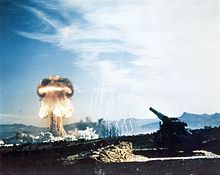W9 (nuclear warhead)
This article includes a improve this article by introducing more precise citations. (September 2022) ) |


The W9 was an American nuclear artillery shell fired from a special 280 mm howitzer. It was produced starting in 1952 and all were retired by 1957, being superseded by the W19.
Description
The W9 was 11 inches (280 mm) in diameter, 54.8 in (1,390 mm) long, and weighed 850 lb (390 kg). It had an explosive yield of 15
The W9 was a gun-type nuclear weapon, using around 50 kg (110 lb) of highly enriched uranium in one large rings assembly and one smaller bullet, which was fired down a tube by conventional explosives into the rings assembly to achieve critical mass and detonate the weapon.[citation needed]
The W9 units which were retired in 1957 were recycled into lower yield T-4 Atomic Demolition Munitions. These were the first (semi) man-portable nuclear weapons.
Tests
The W9 is only the second gun-type nuclear weapon known to have been detonated; the first was the Little Boy nuclear weapon used in World War II.
The W9 artillery shell was test fired once, fired from the "Atomic Annie"
Subsequently, the
